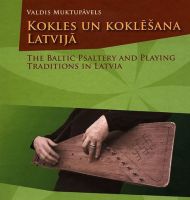Time to strum your kokle again
Apskatīt komentārus (1)
11.02.2010
Amanda Jātniece
Time to strum your kokle again
The Baltic Psaltery and Playing Traditions in Latvia, Lauska, Riga,2009.,117 pages
As Andrejs Jansons books did to the slightly modernized 13-string kokles of a generation and two ago in the communities of exiled Latvians, so Valdis Muktupāvels new instruction book looks set to launch a new generation of kokle players in Latvia. At the book opening event on February 4, already three people admitted that his book had inspired them to buy a kokle and promise to start playing. A man from France had even managed to get an early copy of the book, learn a piece included in it, and send the author a video clip of him playing it quite proficiently.
The history of the kokle most likely stretches back more than two thousand years, but the earliest archaeological testimony of kokle-type instruments in Latvia dates to the 13th century. Muktupāvels writes: The kokle experienced a number of significant changes in the late 19th century and early 20th century due to changes in rural musical life and the introduction of new dances and popular music into the local repertoires. The many zithers imported from Germany and Central Europe served as examples for changes in kokle construction and playing methods. [p. 19] Instrument makers began to make kokle-like instruments with up to 30 strings, double strings, metal pegs, bridges, larger bodies, chromatic tunings, and other modern touches, culminating in the free-standing concert kokles of the second half of the 20th century played with theatrical flourishes of the hands. Playing methods, such as Jansons, also reflected more modern tendencies in music.
However, a handful of old-time players and instruments still existed as of the 1980s, when the Latvian national reawakening was getting under way. An ethnomusicologist named Valdis Muktupāvels and other folklore enthusiasts were able to meet with these last remaining direct bearers of the kokle tradition and learn to play from them, ultimately reviving and popularizing the tradition.
In Latvia today, the kokle is looked upon nostalgicallyat best an innocent symbol of the national reawakening and the rosy Singing Revolution, at worst a schmaltzy relic of Soviet staged national culture. But the instrument may finally be shedding this reputation, what with studies in ethnomusicology now being offered at the Latvian Academy of Music and the first electric kokles showing up on the independent music scene. In his book Kokles un koklēšana Latvijā (The Baltic Psaltery and Playing Traditions in Latvia), Valdis Muktupāvels, now a professor of ethnomusicology at the University of Latvia and expert of Latvian and Baltic traditional and modern music culture, has turned all of his attention back to the traditional koklethe kokle before its 19th and 20th century modernizations.
A good third of Muktupāvels book consists of a history, including photos, of the instrument and the methods of playing it. A person who just wants to get to the meat of the matter and begin playing may find this section too detailed. After learning to play, however, he or she may suddenly take an interest in the history of the instrument as well.
The practical part of the book is divided into three sections: the western (Kurzeme/Suiti) playing style, the eastern (Latgale) style, and a section devoted to expanding the kokles repertoire in order to allow it to evolve as a modern-day instrument. This last section suggests alternate tunings for the instrument and explores how to adapt songs from the vocal tradition to the koklein other words, how to be creative with the instrument and still sound like youre continuing within an established tradition.
Kokles un koklēšana Latvijā is available in a hard cover version for posterity and a spiral bound version for practicality. Both versions contain a CD with tunings, exercises, and repertoire, which is also surprisingly pleasant to listen to just as background music. Muktupāvels includes 18 traditional tunes to learn on the kokle and 11 more songs in the last section, complete with song texts so you can sing along while playing. All tunings, exercises, and songs are written out in musical notation, and diagrams of how to place fingers on strings for particular chords are included wherever needed.
A full English translation is printed alongside the Latvian text. But, if the kokle is such a quintessentially Latvian instrument, why the English translation? It turns out that the instrument, technically considered a psaltery, is common throughout north eastern Europe, from all three Baltic nations into Finland, and well into northwestern Russia as well. Therefore, this book will serve players of related instruments throughout the region. But interest in the kokle now ranges across the globe, toomusic is, after all, a global language. If, however, obtaining a traditional kokle werent difficult enough for an outsider, until now there have practically been no published study materials for traditional playing methods, much less in a language understandable to non-Latvians. Hence the Frenchman who couldnt wait to get his hands on a kokle instruction manual.
Now if only someone would begin mass-producing the instrument itself....






